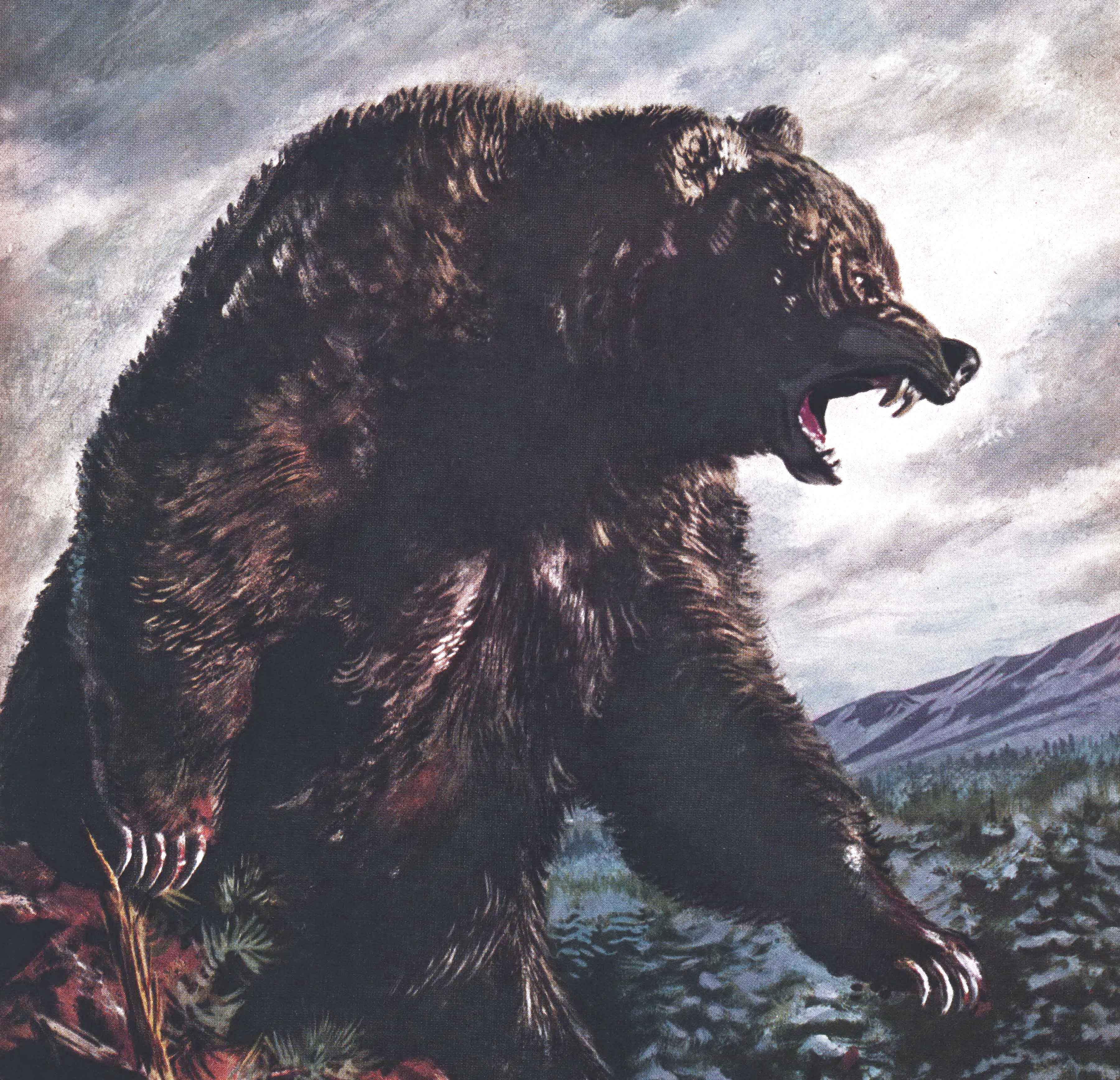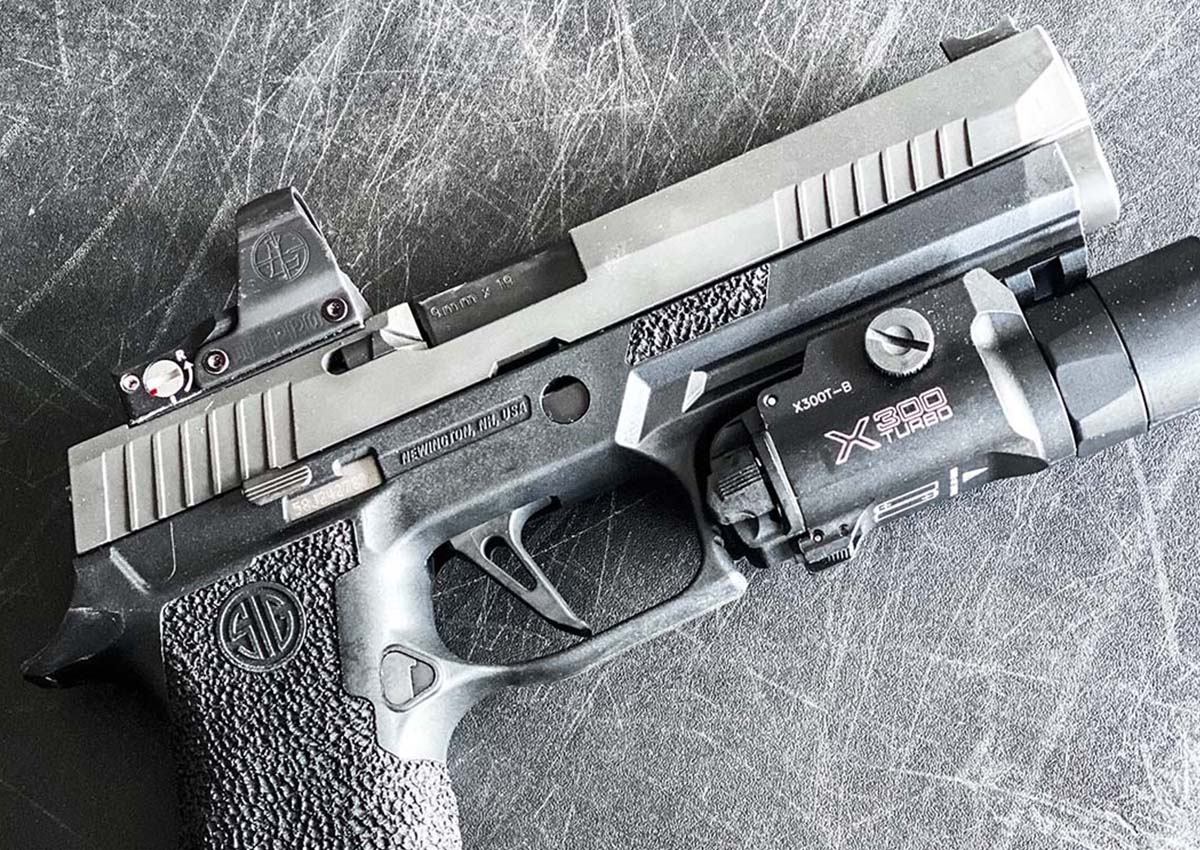A Grizzly Killed Two Bears, Then Charged Me Next. He Should Have Been a World-Record

This story, “For Want of a Bone, a Record Was Lost,” appeared in the September 1953 issue of Outdoor Life.
This fall Ace Demers plans to go to British Columbia to search for a piece of bone — a fragment from the base of a grizzly bear’s skull. The quest will be concentrated in the wild regions of Mt. Boldface in the Itcha Mountains. Seems like looking for a needle in a haystack, but Demers believes he knows just where that hunk of skull is. His reasons for wanting to find it are explained in this story.
For four years I was skunked. Then it happened. One blast from my .375 Magnum rifle in the wilds of British Columbia and I got the reputation of being a big-game hunter. Lots of fellows keep asking me how it happened. They say, “Ace, how come you got interested in shooting big bears? What’s the dope on that hunting trip?” Well, it’s quite a story, and it started with moose.
I operate a flying service, and back in 1947 I was doing aerial dust and spray application work for some farmers in Oregon’s Willamette Valley. The farmers kept swapping stories about hunting in Canada and about killing moose, deer, goats, and even grizzly bears. They got me so steamed up about hunting I made them promise to take me along on their next trip. They said O.K., and made good on it that fall.
Seven of us arranged for a hunt in British Columbia. It was a big operation, and since the fellows seemed sure we’d kill large game we took plenty of equipment with us. We had three pickup trucks and one four-ton job. Quite a caravan. Driving out of the Willamette, we went through Portland, Oreg., crossed the border at Sumas, Wash., on into the Fraser River valley and over good roads to Williams Lake. About 150 miles beyond there, on dirt roads, we came to Trail’s End Lodge at Anahim Lake, our destination.
We were ready to start shooting the minute we arrived, but instead we got together with the guides and planned the hunt. John Glaser and I were to be hunting buddies, and we drew Lester Dorsey as our guide. Lester’s a tall, slim woodsman — a regular storybook guide – who has been in that territory for 35 years. We took a shine to him right away. He described the area we’d hunt in and told us some hair-raising stories about grizzly bears.
“Watch those moose-kill areas,” he warned. “Many times grizzlies take them over and cause trouble.” He explained that after hunters strip a killed moose of horns and whatever meat they want, often a grizzly will move in and claim what’s left. Lester showed us several such places. The moose remains gave off an awful stench and usually were half buried under piles of dirt and debris clawed up by the grizzlies. But we didn’t see any bears.
“I want a big grizzly,” I told Lester.
“First let’s get moose, then we’ll go after bears,” he replied.
By the second day of the hunt every member of our party had a moose — except John and me. We’d seen moose and shot at moose, but that’s all. The .30/06 I was carrying seemed altogether useless.
The fourth day found us on a trail in the Clipper Heights area of the Rainbow Range, and we spotted two bulls breaking ice on a small lake. The distance was about 250 yards. We piled off the horses and pumped lead. After the third or fourth shots the bulls turned and trotted swiftly up the slope. “Didn’t you hit yours?” I asked John.
“I made a sieve out of him,” he shouted. Evidently my .30/06 just didn’t pack enough hitting power. We trailed those bulls for a long time but didn’t catch up with them.
Some days we were in the saddle 12 hours at a stretch. No moose. No nothing. We glared at Lester. Lester glared ahead. Finally we came to the last day of the hunt. Even the weather turned bad. and snow set in. Late in the day we spotted a timber wolf and shot right between his back legs. Snow blew up under his belly. We’d missed again. At dusk the three of us were riding toward a ridge, eye-weary and saddle-sore, when Lester yelled, “Moose, moose, moose!”
Sure enough. Moose all over the slope on the other side of the ridge, like spots before your eyes. The jackpot, and just in time. John and I each collected a moose, and that was that.
The gang was happy back at the lodge. Seven men killed seven moose in seven days. I felt so good I forgot about grizzly bears and headed for Nimpo Lake to do some fishing.
By 1948 the urge for a grizzly was still on me. I couldn’t forget those moose-kill areas and the earth-moving work grizzlies do when making food caches. I wired Lester, “This year we get grizzly bears.” His response wasn’t enthusiastic. Like many other guides, Lester himself has no fear of bears but has reservations about what inexperienced hunters might do when they come across a grizzly for the first time. Just the same, I was determined to get a trophy bear.
The stories I’d heard about grizzlies, together with the poor results I’d had with my .30/06, caused me to get a .300 Magnum. It’s a fast and hard-shooting gun if you use it properly and can handle the recoil. Since I’m short and stubby I figured I could take the kick all right.
John and I teamed up with Lester again in 1948, and this time we had better luck. First day out we spotted a huge bull moose 350 yards away. John and I both ran up the slope to shorten the range, but my greater weight and shorter legs gave John the advantage. He got the first shot, and that did it. After dressing out the moose we were heading for camp when John pointed to a horse in a far meadow. “Horse, nothing,” I said as my scope outlined a fair-size moose. The .300 Magnum paid off on the first shot. Good. Two moose on the first day. Now we could use the remaining six days to hunt bears.
The three of us combed the area. We found lots of bear tracks, but no bears. One day Lester picked up a trail made by a grizzly with a bloody fore-paw. “This ought to be easy,” I thought. But no results. We had to content ourselves with goats, deer, moose, and fish.
Our 1949 and 1950 trips were duplicates of the 1948 hunt. No grizzlies. Then came the fall of 1951. I was working in Mexico at the time, and my hunting partners were getting itchy feet and were worried I’d hold up the trip until too late. This eventually led to a split in the ranks, but I wired John.
“We’ll head for Canada,” I assured him, “and this year it’s a grizzly first.” His answer was kind of indirect.
“I’ve got all arrangements made. We’re going caribou hunting,” he replied. Evidently John wasn’t too keen about hunting grizzlies. Well, the way it worked out was that John went hunting caribou in Alberta with two other friends, and I made my own arrangements.
I phoned Ike Sing early in October. He runs the general store at Anahim Lake and had been our cook on previous trips. “Send a runner to Lester’s ranch,” I told him, “and see if Lester will take me out this year. Tell him I’ve got to have a grizzly. Tell him I want to know if there’s any bear sign around. If he can’t find grizzlies I won’t come up.”
Ike phoned back. “Lester says bear sign good.” That was enough. I went out and traded my .300 Magnum for a real cannon — a .375.
With the pick-up pulling a boat and trailer, it took me two days and a night to make the lake from Salem, Oreg. Snow set in, but I told myself snow’s good for tracking. I met Lester and Ike at the store, and as a starter we arranged a couple of short pack trips on the slopes behind Lester’s 750-acre ranch. It’s near Mt. Baldface in the Itcha mountains at 4,000 feet.
We got nothing on either trip. On the second one we sighted a young bull moose in a meadow, and I stalked him to within 150 yards. But there were two cows with him, and when they saw me they romped and side-kicked to the other end of the clearing. I let the bull go. After all, I was out for a bear.
Lester decided we’d better take a pack train and head for the higher elevations. He and his son loaded nine horses with tents, stoves, food, guns — the works. We were prepared to go all the way to Alaska if necessary. Then we started climbing. Rain and snow pelted us off and on, and before long we ran into a real storm. We camped early that first day, hit a few grouse, and had a nice supper.
Next morning we’d been on the move an hour or so when the pack train was thrown into a panic. A big bull moose popped out of the brush along the trail and stood there looking straight at us. He wouldn’t move. I jumped off my horse, cracked a bullet into the bull’s backbone, and finished him with a head shot. That filled my ticket for moose.
The second day brought us to timberline on Baldface. Lester told me this was grizzly territory for sure. He said the larger animals usually stay on the upper reaches and seldom associate with the fish-eating bears below and around the coastal streams. That sounded good. Lester spent a lot of time searching the area but reported only a few bear tracks. They showed that the animals were moving fast, night and day, and heading for distant places.
On one scouting expedition we ran into Pam Phillips, a guide from another area. “This is a bad year for bears,” he told us. “Surest bet for a grizzly is down around the Bella Coola River where the fish-eaters are catching the fall run of salmon.” He gestured out into the valleys below, toward the coast. It would be a 75-mile jaunt, but that didn’t bother me. I’d been ghost hunting long enough. So our packtrain eased down the slopes toward Lester’s ranch.
From the ranch to Anahim Lake is one day by horseback. At the lake Lester and I took a pick-up and headed toward the coast through Precipice Pass, which actually is a horse trail. In several places the drop-off is straight down 2,000 feet. It was rough, but we made it and ended up at Bert Robson’s place, which is close to Antnirko.
Bert is a guide in that area and a good friend of Lester’s. He’s also an authority on grizzlies and has written a book about them. After we’d told him about our tough luck, he helped us map another campaign: But before we hit the trail again Lester and I had the pleasure of soaking ourselves in Bert’s modern bathtub, a luxury which had been hauled 40 miles on horseback. The first hunt we made was a short one. The second covered more territory. The third was tiring. We tramped for a week and didn’t see a single bear. There were grizzly tracks in the sands along the streams, but no animals. Anyone who thinks grizzlies are easy to track has another think coming. If a grizzly doesn’t want to stand ground he vanishes. In many places we tracked bears right down to the waterline and found fresh fish tossed up on the banks. But no bears. I was almost ready to swear there was no such animal as a grizzly. Yet around Bella Coola I heard plenty of stories that made hitting a bear sound like a pushover.
“There was a guy here last week,” one fellow told me. “Just walked out a mile and shot a grizzly. It bawled, rolled downriver, and washed up on the bank. All we did was pull it up the trail and bring it in.” Fine, but Ace Demers doesn’t get grizzly bears that easily.
Finally I spoke up to Lester. “Let’s get out of here and head back to the hills.” No sooner had I said that than who should walk into Robson’s place but Pam Phillips. He’d made a second trip through Mt. Baldy’s slopes, he said, and had seen grizzly tracks coming down the mountain.
I reacted like I’d been given a shot in the arm. Next day Lester and I were back in Ike’s store at Anahim Lake. Indian trappers kept drifting in and out of the place, and several remarked they’d seen grizzly tracks on the west slopes. Lester and Ike went into a huddle over these rumors, and then we had a conference. The upshot was that Lester felt there might be some truth in the stories.
Straight ahead, not more than 125 feet away, a huge bear stood on its hind legs, pawing over a large dirt mound. It spotted me immediately, let out a ferocious grrooff, grrooff, and lunged for me.
There was a fellow at the store called Olie Johnson, part Indian with some Norwegian and English, who was a bear hunter. Lester said he’d like to get him to join us, and I told him O.K. After some preliminary arrangements, Olie agreed to come along.
We decided Lester would spend a day scouting around his ranch to check for bear sign. If he saw any he’d get the information to Ike Sing, who would notify me at Nimpo Lake where I’d be fishing.
I tramped into Ike’s store on Sunday, October 21, and met a trio of grins.
“What’s up, Lester?” I asked.
“He’s a big one.”
“Are you sure?”
“Yes. Day-old tracks. He’s heading up the mountains.”
“Let’s go. I don’t care if we ride two weeks.”
We outfitted three saddle horses and one pack horse, and hit the trail next morning. The bear was a steady plodder. It was heading straight up the mountain, keeping close to the brush and stubby timber. The going was tough on the horses. The temperature was 12 above, and the dry snow on the trees kept falling on us. But the light snow over the frozen ground didn’t hamper our speed, and it was good for tracking.
We made a quick camp at twilight of the first day. There was no fussing around. A good camp is out of the question when you’re hot on a bear’s trail and the weather is changeable. We unpacked the minimum, built a fire, and made do as best we could. All we talked about was how long it might take to catch up with that bear. At one point the Indian said, “Bear, big bear, but small foot.”
“How’s that?” I asked. “The tracks look big to me.” “Bear never step on log,” he replied. “Bear step here and step over it. Never put any print on log at all. Even when log is big, bear afraid to step. Afraid he break it and make noise.”
What he said about the bear stepping over logs was true, even though in many cases they were 12 inches thick. The bear was keeping his trail in the brush and taking no chances on exposing himself.
I checked the guns before turning in. The Indian’s was rusty and the barrel looked like a gravel road, but he kept it loaded. I kept my .375 Magnum loaded too. After supper we built up the fire and rolled into sleeping bags, and during the night we were buried under a foot of snow.
Next day we hit the trail as early as dawn would permit, and rode in silence. We made good progress for several hours, then held a confab. At no time had the trail taken us other than upward in a relatively straight line. It was evident the bear was· heading for the top elevations of Mt. Baldy. The tracks were becoming more distinct. There was powdery snow in the deep, firm prints, and even the claw marks were well defined.
We pushed ahead in single file with the Indian in the lead. Occasionally he’d stop, jump from his horse, and bend over to examine the ground closely. He seemed more pleased with each inspection. Lester paced his horse behind mine. I was in the middle. For miles there wasn’t a break in the trail, and no sign that the bear had bedded down anywhere.
Late that afternoon we flushed a flock of ravens immediately ahead. I watched the birds scatter, then looked at Olie. The Indian seemed startled, sat uncertainly in his saddle for a minute, then pumped both feet from the stirrups and flew off his horse.
“Fresh bear tracks, fresh bear tracks,” he yelled, pointing excitedly to where the trail led into some dense brush.
I piled off my horse and lit in knee deep snow. Passing Olie, I took the lead and advanced cautiously. Soon there were bear tracks all over, a regular stamping ground. Could this be the end of the trail?
The three of us pushed straight ahead. We stopped a minute 200 feet from where we’d left the horses and surveyed the area. Here the timber had thinned out, giving way to brush and evergreens too bushy to see through. We heard branches crackling.
“Up this way.” Lester gestured from behind.
“Bear over here,” Olie whispered and pointed.
Again I took the lead, moved toward the spot he indicated, and quietly pushed my rifle around the end of a thicket. I bent forward and looked into a sizable clearing.
Straight ahead, not more than 125 feet away, a huge bear stood on its hind legs, pawing over a large dirt mound. It spotted me immediately, let out a ferocious grrooff, grrooff, and lunged for me. I jammed one knee into the snow, leveled the gun at the bear, and put a quick shot into its heart area. As the bullet smashed into it the animal staggered, but came right on. I pumped a fast second shot as the bear pitched into a somersault in front of me. It lay still.
“Never heard or saw a bolt-action rifle give two shots so fast,” Lester said as he ran up. I’d carried five shots, four in the magazine and one in the barrel, and was prepared to let go with the whole works if necessary.
Hesitantly the three of us approached the huge body. The bear was hot and sweaty, and a layer of snow which the fur had picked up when the monster fell was now beginning to melt slowly.
“Lester, don’t get too close,” I shouted, remembering the stories I’d heard. “He might be alive. He might jump up. They’ve done that.”
But Lester walked up close and pointed to the blood oozing from the bear’s underside. “You don’t have to shoot any more,” he said.
I was still cautious. “Well, go around behind and kick him. If he moves I’ll shoot.” Lester and the Indian went around the body and gave it several swipes. There was no movement. I didn’t know until later how well that first bullet had found its mark.
The initial excitement was over, but Lester couldn’t control his enthusiasm. Neither could the Indian.
“Big bear, big bear,” Olie kept shouting. “Biggest bear I ever seen.” Then he rushed over to the body and stepped off its length. “Fourteen feet.” He went through the act again and again and always came up with the same answer. He slapped me on the shoulder, almost knocking me down. All I knew, it was a big bear. I hardly noticed it was a grizzly until I saw its big hump and four-inch fur tipped with silver.
Lester took a good look over the area and said it was the grizzly’s winter food cache. Several hundred feet back on the trail we found the remains of two moose partly buried under leaves and dirt. The ravens we’d flushed had been working them over. Near the moose grave Lester picked up a small piece of brown fur. It looked like wolf skin, but Lester said it was grizzly hide. That was a puzzler. Where had it come from? We couldn’t answer that — not just then.
I walked around the cache area kicking up clumps of debris here and there. Then I jumped up on the large mound which the bear had been pawing over when we surprised him. The pile was four or five feet high, and as I stepped on it it shivered like jelly.
“Hey, there’s a live bear under here,” I yelled to Lester as I jumped clear and got my rifle in position for a shot.
Tester came over to the mound and skinned off about three inches of the outside dirt with his shoe. The dirt was soft and crumbly where it had been defrosted by the heat of the grizzly’s body. Under Lester’s shoe a mass of brown fur was exposed. We both dug deeper and uncovered the carcass of a brown bear ripped and torn and covered with blood. The right shoulder had been clawed from the spine down, and the jaw severed from the skull. No doubt this was the work of the giant grizzly.
With Olie’s help we rolled the remains of the brown bear to one side, and as we did so the mound of dirt yielded another body. This time it was a black bear. The two dead bears had been stacked in a neat pile, one on top of the other, and covered over.
The mound forming the double grave was made up of earth, leaves, small trees, and logs, all scraped over the bodies by the grizzly’s clam-rake paws, and topped with logs six to eight inches in diameter. Despite all this, the mound was so shaky it gave easily when we pushed it.
Now we stopped to figure out the puzzle. Evidently sometime within the previous 24 hours the killer grizzly had had a terrific fight with the two bears that had trespassed on his territory. The cache area was a real battleground, with trees, brush, small vegetation, earth, and snow all plowed up.
When I spotted him, the grizzly undoubtedly was cleaning house and giving his victims a proper burial. All the time we’d been tracking him the wind had been in our favor, and the monster was genuinely surprised when we jumped him.
Tester told me grizzly bears often set up winter quarters in food-cache areas. So it had been with this fellow, for we found a bed of boughs and sticks near the mound. Lester thought the grizzly had left his cache now and again to raid ranches on the lower mountain slopes. We picked up his trail while he’d been exploring the rangeland near Lester’s place.
While the grizzly was on this raiding expedition, a smaller grizzly must have invaded the area. It probably was snooping around the moose remains when it was surprised and overpowered by either the black bear or the brownie, or maybe both. Hence the hunk of grizzly fur Lester found. Then, to complete the drama, the big grizzly had caught the two intruders and slaughtered them in a battle royal.
After we’d done fitting this jig-saw puzzle together we turned back to the grizzly. Its body was so large and fat that the chubby paws just hung in a playful form across one side, not touching the ground.
“He’s an old bear,” the Indian said. To which Lester added, “Biggest I’ve ever seen. Didn’t think they came so big.”
It was dark when we started skinning the bear, and it took us until midnight to finish the job. We found lard four or five inches thick immediately under the skin. Our hunting knives turned dull in no time, and we had no whetstone with us. By the time we had that hide loose we were so tired we could have fallen asleep right there in the snow.
I wanted to see what damage my two shots had done, so we did a little surgery. The first killed the bear outright, blew his heart to bits. Yet that 300-grain bullet with its 4,400 pounds of shocking power never got beyond the chest cavity. It was stopped cold by the grizzly’s thick, tough muscles. The second bullet had ripped a three-inch gouge out of a tree trunk, but had gone on to blast the bear on top of the shoulder.
In the four years I’d spent prowling around British Columbia after a grizzly, I’d heard guides relate the fates of many hunters bent on similar missions. Usually the guides told of being left to shoot bears while their hunters hightailed it for cover. Lester and Olie risked no such danger with me. I’m not built for high-tailing it anywhere. I weigh 235 pounds and stand 5 feet 8 inches in riding chaps, and any bear would see at a glance that I’d be going nowhere fast. The situation I faced offered no alternatives. I had to stand my ground and shoot.
Next morning we got ready to head back to the ranch. The worst problem we ran into was loading the grizzly on the packhorse, a big roan mare. She wanted nothing to do with it. She jumped to one side, then the other, kicked, bucked, and tried to roll the hide off. Anything to get away from that grizzly smell.
Even with the roan under control we had a tough time because the skin was so heavy and slippery it wouldn’t stay put. It kept shifting around like liquid. We’d left quite a bit of fat on the underside, intending to do a real cleaning job later, and Lester figured that the fat and the skin weighed 350 pounds. We tucked the greasy bundle into two rawhide saddle bags —one on each side of the horse and lopped the skin from one bag to the other over the roan’s back. She didn’t care for that one bit. But we got under way and highballed it down the side of the mountain.
Ike Sing was on hand to hear the news. As I told him the story he kept looking at the hide. “You got a big bear there,” he said. He didn’t think the skin weighed as much as it did, though, until we had him heft it. “What do you think now, Ike?” He smiled and nodded vigorously. “You got a record, maybe even a world record.”
We rolled the remains of the brown bear to one side, and as we did so the mound of dirt yielded another body. This time it was a black bear. The two dead bears had been stacked in a neat pile, one on top of the other, and covered over.
After we’d done a little celebrating we started cleaning off the hide, and filled a big tub with fat. While we were scraping away Olie kept taking time out to step back off the hide, look at it, and wag his head. “Big bear, big bear,” he kept saying. When we’d finished we packed the hide with the skull, and I started out for home.
As I drove south from Anahim Lake the report I’d got a big bear spread ahead of me. I had to stop dozens of times to show the skull and hide. Finally I got so tired of rolling the hide back into the rye-grass sack each time folks had seen it, I just left it piled up loosely in the back of the pick-up.
When I got to the border the Canadian officials who checked the hide and skull said they’d never seen or heard of a grizzly that big, and suggested I write to the provincial government and record its size.
But after I got back to Salem, Oreg., I had other things to do and didn’t think much about all the talk there’d been of how big the bear was, or of what Ike Sing had said about maybe I had a world record. Then the local newspaper wanted a story, and the reporter asked me if I’d rack up the skin for a photograph. I put the hide on a 14 x 14-foot frame and stood next to it to have my picture taken.
After the newspaper article appeared I got up enough enthusiasm to call Jim Bond, a big-game hunter, at Seattle, Wash. He told me that if the trophy was as big as all that I should send the skull to the American Museum of Natural History in New York City.
“They’ll record it for you,” he said, “and if you have a world record they’ll tell you so.”
I shipped the skull to New York by plane, and soon got a letter from Samuel B. Webb, chairman of the Boon and Crockett Club’s Committee on North American Big Game. My trophy, he assured me, would be well up on the list. Then Mrs. Grancel Fitz, the committee’s secretary, wrote, asking me for more facts about the trophy and telling me it would be entered in the club’s 1951 competition. I could scarcely wait to hear the results.
The news came in March, 1952. I learned that my grizzly had placed third in the 1951 competition. Its skull, measured without the lower jaw, was 15 13/16 inches long, while the skull that took first prize was 16 inches long — just 3/16 more. My trophy ran up a total score of 25 5/16 points, compared with 25 6/17 [sic] points for the winner. In addition, my trophy placed fourth on the newly compiled world-record list for grizzlies. Length of the present No. 1 grizzly skull is 16 3/16 inches, only 3/8 of an inch longer than mine.
Maybe my story should end there, but Mrs. Fitz told me something about my trophy I never thought about before. It appears that when the skull was taken from the grizzly’s spine it was cut short. “Sawing the back off, as it has been done,” she wrote, “was a great loss to your fine trophy. In fact, you might have had a world record. Of course this is only a guess.”
Read Next: My Buddy and Our Hounds Were No Match for the Ghost-Town Grizzly of Old New Mexico
Well, it’s no guess to me. The committee could only measure what it had, but I know that at least two inches of bone were sawed off the skull and left attached to the rest of the body. That’s why I’m convinced my grizzly deserves to rank as the world record, and I hope to prove it by finding that missing chunk of bone. I would have gone back last year except for the ban on bringing meat into the United States.
I’ve already arranged with Lester Dorsey for a hunt this fall, and the first item on the program will be to look for that piece of skull. Both Lester and I know exactly where we left the grizzly’s remains, and have hopes the skeleton will still be there. I want to find the missing link that should put my trophy up front, where I’m sure it belongs.
Read the full article here







